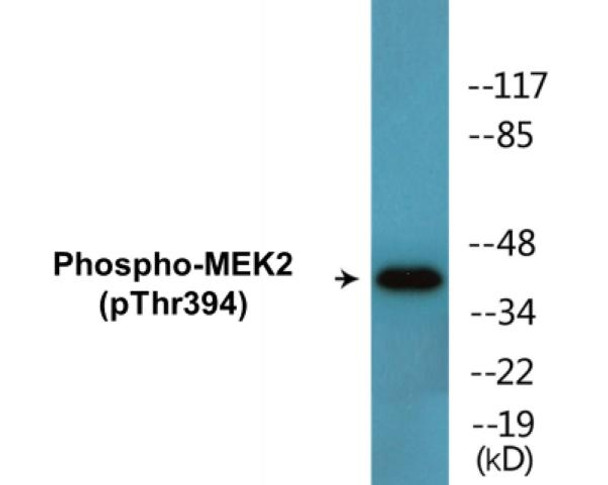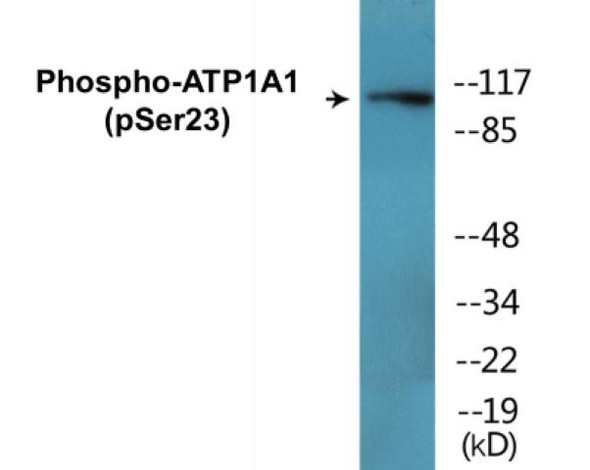MEK2 (Phospho-Thr394) Colorimetric Cell-Based ELISA Kit
- SKU:
- CBCAB01568
- Product Type:
- ELISA Kit
- ELISA Type:
- Cell Based Phospho Specific
- Reactivity:
- Human
- Mouse
- Rat
- Detection Method:
- Colorimetric
Description
MEK2 (Phospho-Thr394)Colorimetric Cell-Based ELISA Kit
The MEK2 Phospho-Thr394 Colorimetric Cell-Based ELISA Kit is specially designed for the accurate measurement of MEK2 phosphorylated at threonine 394 in cell lysates. This kit offers high sensitivity and specificity, ensuring reliable and reproducible results for your research needs.MEK2, also known as MAP2K2, is a key protein kinase in the MAP kinase pathway that plays a crucial role in cell proliferation, differentiation, and survival. Phosphorylation of MEK2 at threonine 394 has been implicated in various cellular processes, including tumorigenesis and drug resistance.
Detecting and quantifying this phosphorylation event can provide valuable insights into these pathways and potential therapeutic targets.With easy-to-follow protocols and a quick colorimetric readout, the MEK2 Phospho-Thr394 Colorimetric Cell-Based ELISA Kit is an essential tool for studying signaling pathways and developing targeted therapies for cancer and other diseases. Order yours today to advance your research with confidence.
| Product Name: | MEK2 (Phospho-Thr394) Colorimetric Cell-Based ELISA |
| Product Code: | CBCAB01568 |
| ELISA Type: | Cell-Based |
| Target: | MEK2 (Phospho-Thr394) |
| Reactivity: | Human, Mouse, Rat |
| Dynamic Range: | > 5000 Cells |
| Detection Method: | Colorimetric 450 nm |
| Format: | 2 x 96-Well Microplates |
The MEK2 (Phospho-Thr394) Colorimetric Cell-Based ELISA Kit is a convenient, lysate-free, high throughput and sensitive assay kit that can detect MEK2 protein phosphorylation and expression profile in cells. The kit can be used for measuring the relative amounts of phosphorylated MEK2 in cultured cells as well as screening for the effects that various treatments, inhibitors (ie. siRNA or chemicals), or activators have on MEK2 phosphorylation.
Qualitative determination of MEK2 (Phospho-Thr394) concentration is achieved by an indirect ELISA format. In essence, MEK2 (Phospho-Thr394) is captured by MEK2 (Phospho-Thr394)-specific primary (1ø) antibodies while the HRP-conjugated secondary (2ø) antibodies bind the Fc region of the 1ø antibody. Through this binding, the HRP enzyme conjugated to the 2ø antibody can catalyze a colorimetric reaction upon substrate addition. Due to the qualitative nature of the Cell-Based ELISA, multiple normalization methods are needed:
| 1. | A monoclonal antibody specific for human GAPDH is included to serve as an internal positive control in normalizing the target absorbance values. |
| 2. | Following the colorimetric measurement of HRP activity via substrate addition, the Crystal Violet whole-cell staining method may be used to determine cell density. After staining, the results can be analysed by normalizing the absorbance values to cell amounts, by which the plating difference can be adjusted. |
| Database Information: | Gene ID: 5606, UniProt ID: P36507, OMIM: 115150/601264, Unigene: Hs.465628 |
| Gene Symbol: | MAP2K2 |
| Sub Type: | Phospho |
| UniProt Protein Function: | MEK2: a dual-specificity protein kinase of the STE7 kinase family. Phosphorylated and activated by Raf and Mos kinases. Phosphorylates a Thr and a Tyr residue in a Thr-Glu-Tyr sequence located in the activation loop of ERK2 and ERK3. A component of MAP kinase signal transduction pathways involved in mitogen growth factor signal transduction. |
| UniProt Protein Details: | Protein type:EC 2.7.12.2; Protein kinase, dual-specificity (non-receptor); Protein kinase, STE; Kinase, protein; STE group; STE7 family Chromosomal Location of Human Ortholog: 19p13.3 Cellular Component: Golgi apparatus; peroxisomal membrane; microtubule; internal side of plasma membrane; focal adhesion; mitochondrion; endoplasmic reticulum; early endosome; extracellular region; intercellular junction; cell cortex; cytosol; perinuclear region of cytoplasm; late endosome; cytoplasm; nucleus Molecular Function:MAP kinase kinase activity; protein serine/threonine kinase activity; protein serine/threonine kinase activator activity; protein binding; protein-tyrosine kinase activity; protein serine/threonine/tyrosine kinase activity; protein complex scaffold; ATP binding; PDZ domain binding Biological Process: epidermal growth factor receptor signaling pathway; axon guidance; fibroblast growth factor receptor signaling pathway; peptidyl-tyrosine phosphorylation; activation of MAPKK activity; nerve growth factor receptor signaling pathway; activation of MAPK activity; MyD88-independent toll-like receptor signaling pathway; MAPKKK cascade; stress-activated MAPK cascade; pathogenesis; toll-like receptor 3 signaling pathway; toll-like receptor 2 signaling pathway; toll-like receptor 10 signaling pathway; MyD88-dependent toll-like receptor signaling pathway; toll-like receptor 5 signaling pathway; regulation of stress-activated MAPK cascade; small GTPase mediated signal transduction; Ras protein signal transduction; insulin receptor signaling pathway; toll-like receptor signaling pathway; innate immune response; toll-like receptor 9 signaling pathway; vascular endothelial growth factor receptor signaling pathway; toll-like receptor 4 signaling pathway Disease: Cardiofaciocutaneous Syndrome 4 |
| NCBI Summary: | The protein encoded by this gene is a dual specificity protein kinase that belongs to the MAP kinase kinase family. This kinase is known to play a critical role in mitogen growth factor signal transduction. It phosphorylates and thus activates MAPK1/ERK2 and MAPK2/ERK3. The activation of this kinase itself is dependent on the Ser/Thr phosphorylation by MAP kinase kinase kinases. Mutations in this gene cause cardiofaciocutaneous syndrome (CFC syndrome), a disease characterized by heart defects, cognitive disability, and distinctive facial features similar to those found in Noonan syndrome. The inhibition or degradation of this kinase is also found to be involved in the pathogenesis of Yersinia and anthrax. A pseudogene, which is located on chromosome 7, has been identified for this gene. [provided by RefSeq, Jul 2008] |
| UniProt Code: | P36507 |
| NCBI GenInfo Identifier: | 547915 |
| NCBI Gene ID: | 5605 |
| NCBI Accession: | P36507.1 |
| UniProt Related Accession: | P36507 |
| Molecular Weight: | |
| NCBI Full Name: | Dual specificity mitogen-activated protein kinase kinase 2 |
| NCBI Synonym Full Names: | mitogen-activated protein kinase kinase 2 |
| NCBI Official Symbol: | MAP2K2 |
| NCBI Official Synonym Symbols: | CFC4; MEK2; MKK2; MAPKK2; PRKMK2 |
| NCBI Protein Information: | dual specificity mitogen-activated protein kinase kinase 2 |
| UniProt Protein Name: | Dual specificity mitogen-activated protein kinase kinase 2 |
| UniProt Synonym Protein Names: | ERK activator kinase 2; MAPK/ERK kinase 2; MEK 2 |
| UniProt Gene Name: | MAP2K2 |
| UniProt Entry Name: | MP2K2_HUMAN |
| Component | Quantity |
| 96-Well Cell Culture Clear-Bottom Microplate | 2 plates |
| 10X TBS | 24 mL |
| Quenching Buffer | 24 mL |
| Blocking Buffer | 50 mL |
| 15X Wash Buffer | 50 mL |
| Primary Antibody Diluent | 12 mL |
| 100x Anti-Phospho Target Antibody | 60 µL |
| 100x Anti-Target Antibody | 60 µL |
| Anti-GAPDH Antibody | 60 µL |
| HRP-Conjugated Anti-Rabbit IgG Antibody | 12 mL |
| HRP-Conjugated Anti-Mouse IgG Antibody | 12 mL |
| SDS Solution | 12 mL |
| Stop Solution | 24 mL |
| Ready-to-Use Substrate | 12 mL |
| Crystal Violet Solution | 12 mL |
| Adhesive Plate Seals | 2 seals |
The following materials and/or equipment are NOT provided in this kit but are necessary to successfully conduct the experiment:
- Microplate reader able to measure absorbance at 450 nm and/or 595 nm for Crystal Violet Cell Staining (Optional)
- Micropipettes with capability of measuring volumes ranging from 1 µL to 1 ml
- 37% formaldehyde (Sigma Cat# F-8775) or formaldehyde from other sources
- Squirt bottle, manifold dispenser, multichannel pipette reservoir or automated microplate washer
- Graph paper or computer software capable of generating or displaying logarithmic functions
- Absorbent papers or vacuum aspirator
- Test tubes or microfuge tubes capable of storing ≥1 ml
- Poly-L-Lysine (Sigma Cat# P4832 for suspension cells)
- Orbital shaker (optional)
- Deionized or sterile water
*Note: Protocols are specific to each batch/lot. For the correct instructions please follow the protocol included in your kit.
| Step | Procedure |
| 1. | Seed 200 µL of 20,000 adherent cells in culture medium in each well of a 96-well plate. The plates included in the kit are sterile and treated for cell culture. For suspension cells and loosely attached cells, coat the plates with 100 µL of 10 µg/ml Poly-L-Lysine (not included) to each well of a 96-well plate for 30 minutes at 37 °C prior to adding cells. |
| 2. | Incubate the cells for overnight at 37 °C, 5% CO2. |
| 3. | Treat the cells as desired. |
| 4. | Remove the cell culture medium and rinse with 200 µL of 1x TBS, twice. |
| 5. | Fix the cells by incubating with 100 µL of Fixing Solution for 20 minutes at room temperature. The 4% formaldehyde is used for adherent cells and 8% formaldehyde is used for suspension cells and loosely attached cells. |
| 6. | Remove the Fixing Solution and wash the plate 3 times with 200 µL 1x Wash Buffer for five minutes each time with gentle shaking on the orbital shaker. The plate can be stored at 4 °C for a week. |
| 7. | Add 100 µL of Quenching Buffer and incubate for 20 minutes at room temperature. |
| 8. | Wash the plate 3 times with 1x Wash Buffer for 5 minutes each time. |
| 9. | Add 200 µL of Blocking Buffer and incubate for 1 hour at room temperature. |
| 10. | Wash 3 times with 200 µL of 1x Wash Buffer for 5 minutes each time. |
| 11. | Add 50 µL of 1x primary antibodies Anti-MEK2 (Phospho-Thr394) Antibody, Anti-MEK2 Antibody and/or Anti-GAPDH Antibody) to the corresponding wells, cover with Parafilm and incubate for 16 hours (overnight) at 4 °C. If the target expression is known to be high, incubate for 2 hours at room temperature. |
| 12. | Wash 3 times with 200 µL of 1x Wash Buffer for 5 minutes each time. |
| 13. | Add 50 µL of 1x secondary antibodies (HRP-Conjugated AntiRabbit IgG Antibody or HRP-Conjugated Anti-Mouse IgG Antibody) to corresponding wells and incubate for 1.5 hours at room temperature. |
| 14. | Wash 3 times with 200 µL of 1x Wash Buffer for 5 minutes each time. |
| 15. | Add 50 µL of Ready-to-Use Substrate to each well and incubate for 30 minutes at room temperature in the dark. |
| 16. | Add 50 µL of Stop Solution to each well and read OD at 450 nm immediately using the microplate reader. |
(Additional Crystal Violet staining may be performed if desired – details of this may be found in the kit technical manual.)










